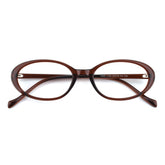Popular Products
How to Know Your Frame Size?
Selecting the right frame size is crucial before purchasing glasses, as an ill-fitting frame can be inconvenient and require replacements. To determine your ideal frame size, follow these steps:
- Take out your old frame and find the 3 numbers on the temples.
- Compare the detailed numbers from your old frame with the ranges in the table to find your perfect frame size.
- Use the size filter on our landing page to easily filter frames that match your preferred size.
Each Measurement about the Frame
When choosing the perfect eyeglasses or sunglasses, it's essential to understand each measurement associated with the frame. Here's more information about each measurement:
Lens Width
The horizontal width of each lens, measured at its widest point, is commonly known as the "eye size" or "lens width." It usually falls within a range of 40 mm to 60 mm.
The lens width is a crucial measurement as it affects both the fit and the style of the eyewear. It is essential to choose the right lens width to ensure that the lenses adequately cover the eyes and provide optimal vision correction. Additionally, the lens width plays a role in determining the overall appearance and proportion of the eyeglasses or sunglasses on the wearer's face.
The lens width is a crucial measurement as it affects both the fit and the style of the eyewear. It is essential to choose the right lens width to ensure that the lenses adequately cover the eyes and provide optimal vision correction. Additionally, the lens width plays a role in determining the overall appearance and proportion of the eyeglasses or sunglasses on the wearer's face.
Lens Height
The vertical measurement of the lens in a pair of eyeglasses or sunglasses. It is the distance from the bottom edge of the lens to the top edge, also known as the "optical center" of the lens. Lens height is an important measurement, especially for individuals who require bifocal or progressive lenses or prefer larger frames for aesthetic reasons.
Lens Bridge
Also known as the bridge width, is a critical measurement that refers to the distance between the two lenses. It is the part of the frame that spans the gap between the left and right lenses, resting on the wearer's nose.
Temple (Arm) Length
Also known as the arm length or temple arm length. These arms extend from the frame's front and go over the ears to hold the eyewear securely in place on the wearer's face.
Finding the appropriate temple length is essential for ensuring a comfortable fit and proper positioning of the glasses on the wearer's face. If the temple arms are too short, they may pinch behind the ears and feel uncomfortable. Conversely, if the temple arms are too long, the glasses may slide down the nose or sit too low on the face.
Finding the appropriate temple length is essential for ensuring a comfortable fit and proper positioning of the glasses on the wearer's face. If the temple arms are too short, they may pinch behind the ears and feel uncomfortable. Conversely, if the temple arms are too long, the glasses may slide down the nose or sit too low on the face.
Frame Width
Also known as the total frame width or temple-to-temple width, is an essential measurement that indicates the total width of the frame from one end to the other. It is typically measured horizontally across the front of the frame, including both lenses and the bridge.
Finding the right frame width is crucial to ensure that the eyewear fits the individual's face comfortably and securely. If the frame width is too narrow, the temples may feel tight or uncomfortable behind the ears. On the other hand, if the frame width is too wide, the glasses may constantly slide down the nose and not sit properly on the face.
Finding the right frame width is crucial to ensure that the eyewear fits the individual's face comfortably and securely. If the frame width is too narrow, the temples may feel tight or uncomfortable behind the ears. On the other hand, if the frame width is too wide, the glasses may constantly slide down the nose and not sit properly on the face.
- Choosing a selection results in a full page refresh.











